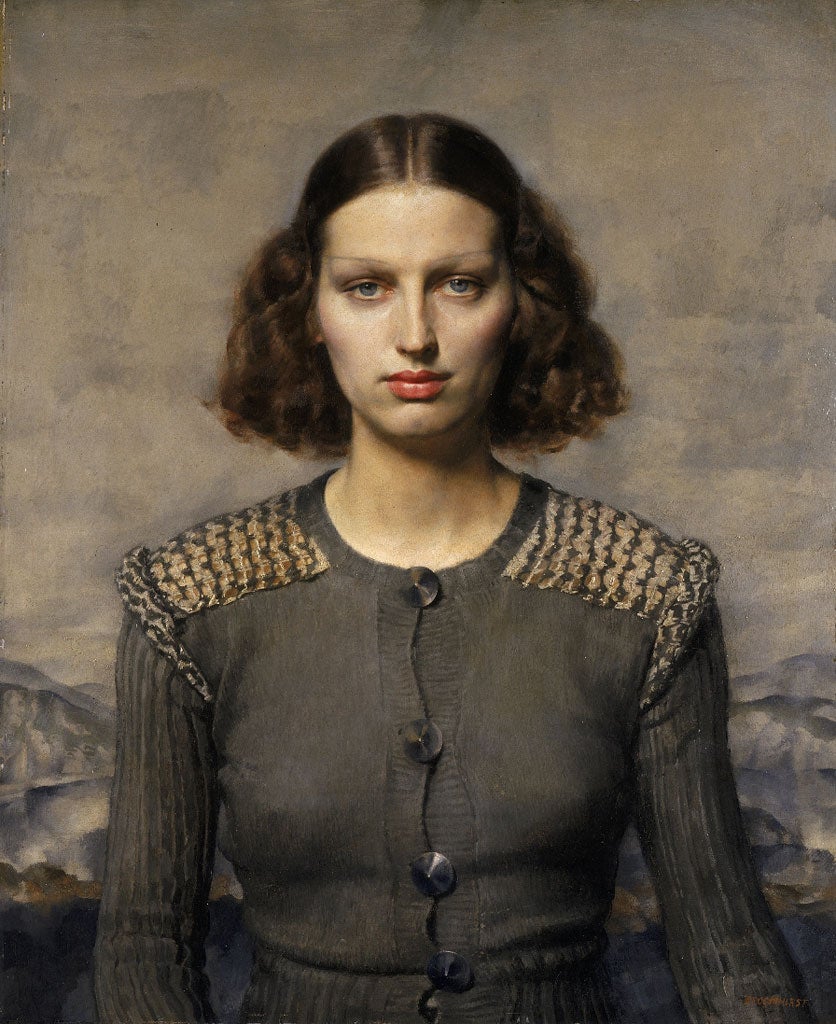Great Works: Jeunesse Doree, 1934 (76.2cm x 63.1cm), Gerard Brockhurst
Lady Lever Art Gallery, Liverpool

So many portraits manage to keep their distance from the onlooker, and we quite like them for that. They are set apart from us for a variety of reasons. The sitter may be looking askance, or he or she may be pottering about the kitchen garden, in profile. In those circumstances we feel that we are wholly in charge of the looking. It is our business to make the acquaintance of the subject on our terms, and at a speed of our choice.
Not so with this portrait by the strange, mercurial Gerald Brockhurst, who is here painting a somewhat glacially idealized portrait of an elegant young woman, a beautiful painter's model, who would later became his second wife. Her first name when he met her was Kathleen. He later re-named her, fancifully, Dorette. This is Dorette, that gilded youth of the title, without a doubt. It is also as direct a piece of slightly unnerving eyeballing as you are ever likely to find. To a degree, you could say that Brockhurst was something of a society painter in so far as he became celebrated for painting the famous – J Paul Getty, Marlene Dietrich and the Duchess of Windsor all sat to him, for example. But when it comes to the final analysis, it was always Brockhurst who was in control. The portrait is as full of psychological manipulation as this Hitchcock of the easel ever managed to achieve.
Brockhurst's portraits, in short, are unnerving. His sitters often seem to be more predators than preyed upon. When we look at this portrait of a woman, we are inclined to step back a pace or two. It is not that we have invaded her space. Rather, she has invaded ours. She is already too much with us. We feel that she knows more about us than we want her to know, and that, without due care and attention, she would be more than inclined to blurt it all out at the drop of a hat. There is also something curiously, disturbingly peaceable about her manner – a troubling calmness before a storm perhaps. She is not inclined to berate us in public for being who we are. Her business is to look at us, and to take stock.
This is full-face portraiture with a vengeance, and it seems to come at us from exactly the right height within the picture frame. It is a painted assignation. The look is settled, cool, the gaze intense, though also entirely inscrutable. Those strange, thinly winged eyebrows catch our attention, immediately, as does the fullness of the lips. The greyness of her dress is slightly disturbing too. Almost martial. As are the pointy, substantial, shield-like buttons on that dress. Her nipples are overstatedly understated, you may also have noticed. In short, she has designs upon us. Is she indoors or out of doors – or positioned in some ill-defined space in between?
Many paintings are contained and defined by their settings – an average 18th-century portrait by its country park, for example. In those cases, we understand the context of the sitter. We understand how he or she fits into the world of which he or she is a part. Here there is something slightly askew or amiss. This woman is fairly lightly dressed, as if for a relatively warm interior. But what is this ill-defined space that she is stepping through? Is it a terrace? Is this a fairly wild Alpine scene behind her? And, if so, how does it marry with that dress? Most of all, it looks perhaps like a painting of an Alpine scene, or one of those curiously unconvincing cinematic backdrops of an Alpine scene in front of a which a small, snarly red racing car is swerving violently from left to right. And Dorette – oh my! – has just stepped out of it.
ABOUT THE ARTIST
The precocious painter and etcher Gerard Brockhurst (1890-1978) - he was admitted to the Birmingham School of Art at the tender age of 12 – had a formidable reputation as a fashionable portrait painter during his lifetime. Negative opinions about the occasional loucheness of his work caused him to leave England for America in the 1930s, where he became even more celebrated and famous. His two wives were his principal models.
Subscribe to Independent Premium to bookmark this article
Want to bookmark your favourite articles and stories to read or reference later? Start your Independent Premium subscription today.

Join our commenting forum
Join thought-provoking conversations, follow other Independent readers and see their replies